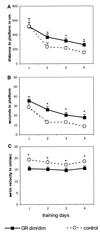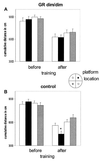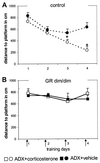Point mutation in the mouse glucocorticoid receptor preventing DNA binding impairs spatial memory
- PMID: 11606764
- PMCID: PMC60132
- DOI: 10.1073/pnas.231313998
Point mutation in the mouse glucocorticoid receptor preventing DNA binding impairs spatial memory
Abstract
Activation of central glucocorticoid receptors caused by the stress that is associated with a learning task facilitates storage of the acquired information. The molecular mechanism underlying this phenomenon is entirely unknown. Glucocorticoid receptors can influence transcription both through DNA binding-dependent and -independent mechanisms. To assess the importance of these two modes of action for spatial memory, we here used male mutant mice in which homodimerization and DNA binding of the glucocorticoid receptor is largely prevented (GR(dim/dim)) while protein-protein interactions still can take place. These mice showed a selective impairment of spatial memory in the water maze. Locomotion and anxiety-related parameters measured in an open field and a light/dark preference task were comparable for mutant and control mice. Mutant mice released more corticosterone than control mice under basal resting conditions and in response to swimming, which could have influenced memory processes of the mice. However, mimicking the task-related increase in corticosterone by supplementary injection of corticosterone (250 microg/kg, i.p.) in adrenalectomized mice, resulting in equal plasma corticosterone concentrations in both genotypes, improved spatial memory of control mice but had no effect on mutant mice. These findings suggest that task-related facilitating effects of corticosterone on spatial memory indeed depend on DNA binding of the glucocorticoid receptor rather than on protein-protein interactions of the receptor with other transcription factors. Although it cannot be excluded that both processes are involved in a coordinated way, interrupting the DNA-binding capacity of the receptor is sufficient to induce impairment.
Figures




Similar articles
-
Support for a bimodal role for type II adrenal steroid receptors in spatial memory.Neurobiol Learn Mem. 1999 Jul;72(1):39-46. doi: 10.1006/nlme.1998.3898. Neurobiol Learn Mem. 1999. PMID: 10371714
-
Central mineralocorticoid receptors are indispensable for corticosterone-induced impairment of memory retrieval in rats.Neuroscience. 2007 Nov 23;149(4):729-38. doi: 10.1016/j.neuroscience.2007.08.016. Epub 2007 Aug 14. Neuroscience. 2007. PMID: 17945427
-
Analysis of the stress response in rats trained in the water-maze: differential expression of corticotropin-releasing hormone, CRH-R1, glucocorticoid receptors and brain-derived neurotrophic factor in limbic regions.Neuroendocrinology. 2005;82(5-6):306-19. doi: 10.1159/000093129. Epub 2006 May 4. Neuroendocrinology. 2005. PMID: 16721035
-
The role and mechanisms of action of glucocorticoid involvement in memory storage.Neural Plast. 1998 Jul-Sep;6(3):41-52. doi: 10.1155/NP.1998.41. Neural Plast. 1998. PMID: 9920681 Free PMC article. Review.
-
Mutagenesis of the glucocorticoid receptor in mice.J Steroid Biochem Mol Biol. 1999 Apr-Jun;69(1-6):253-9. doi: 10.1016/s0960-0760(99)00041-2. J Steroid Biochem Mol Biol. 1999. PMID: 10418999 Review.
Cited by
-
An emerging role for microglia in stress-effects on memory.Eur J Neurosci. 2022 May;55(9-10):2491-2518. doi: 10.1111/ejn.15188. Epub 2021 May 4. Eur J Neurosci. 2022. PMID: 33724565 Free PMC article. Review.
-
False Opposing Fear Memories Are Produced as a Function of the Hippocampal Sector Where Glucocorticoid Receptors Are Activated.Front Behav Neurosci. 2020 Aug 26;14:144. doi: 10.3389/fnbeh.2020.00144. eCollection 2020. Front Behav Neurosci. 2020. PMID: 33005133 Free PMC article.
-
Role of mineralocorticoid receptors on the hypothalamus-pituitary-adrenal axis in humans.Endocrine. 2013 Feb;43(1):51-8. doi: 10.1007/s12020-012-9750-8. Epub 2012 Jul 27. Endocrine. 2013. PMID: 22836869 Review.
-
Mineralocorticoid receptor overexpression differentially modulates specific phases of spatial and nonspatial memory.J Neurosci. 2007 Jul 25;27(30):8046-52. doi: 10.1523/JNEUROSCI.1187-07.2007. J Neurosci. 2007. PMID: 17652595 Free PMC article.
-
Reduced glucocorticoid receptors: consequence or cause of depression?Trends Endocrinol Metab. 2006 May-Jun;17(4):124-5. doi: 10.1016/j.tem.2006.03.002. Epub 2006 Mar 30. Trends Endocrinol Metab. 2006. PMID: 16574425 Free PMC article.
References
-
- McEwen B S, de Kloet E R, Rostene W. Physiol Rev. 1986;66:1121–1188. - PubMed
-
- de Kloet E R. Front Neuroendocrinol. 1991;12:95–164.
-
- Oitzl M S, Fluttert M, de Kloet E R. Eur J Neurosci. 1994;6:1072–1079. - PubMed
-
- Sandi C, Rose S P R. Brain Res. 1994;647:106–112. - PubMed
-
- Sandi C, Loscertales M, Guaza C. Eur J Neurosci. 1997;9:637–642. - PubMed
Publication types
MeSH terms
Substances
LinkOut - more resources
Full Text Sources
Other Literature Sources
Medical
Molecular Biology Databases

